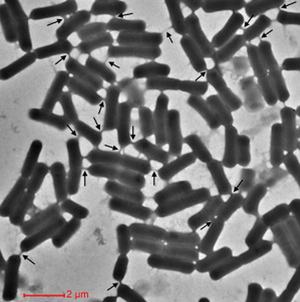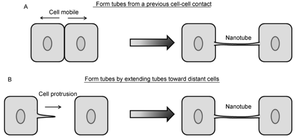Nanotubes facilitate intercellular signaling in eukaryotic and prokaryotic cells: Difference between revisions
No edit summary |
No edit summary |
||
| Line 24: | Line 24: | ||
==Formation== | ==Formation== | ||
[[Image: | [[Image:Screen Shot 2015-04-20 at 2.29.57 PM.png|thumb|300px|right|Figure 2. Two general modes of nanotube formation between cells. (A.) Previously adjoined cells can dislodge, forming a trailing nanotube. (B.) One cell can grow a cellular protrusion and use it to make contact with another cell. [10]<br> | ||
<http://link.springer.com/article/10.1007%2Fs11427-013-4548-3>.]] | <http://link.springer.com/article/10.1007%2Fs11427-013-4548-3>.]] | ||
<br>Include some current research in each topic, with at least one figure showing data.<br> | <br>Include some current research in each topic, with at least one figure showing data.<br> | ||
Revision as of 18:34, 20 April 2015
Overview

<http://www.sciencedirect.com/science?_ob=MiamiCaptionURL&_method=retrieve&_eid=1-s2.0-S009286741100016X&_image=1-s2.0-S009286741100016X-figs5.jpg&_cid=272196&_explode=defaultEXP_LIST&_idxType=defaultREF_WORK_INDEX_TYPE&_alpha=defaultALPHA&_ba=&_rdoc=1&_fmt=FULL&_issn=00928674&_pii=S009286741100016X&md5=b2d22cbeb0a19edbc6d02597fb061a4d>.
At right is a sample image insertion. It works for any image uploaded anywhere to MicrobeWiki. The insertion code consists of:
Double brackets: [[
Filename: PHIL_1181_lores.jpg
Thumbnail status: |thumb|
Pixel size: |300px|
Placement on page: |right|
Legend/credit: Electron micrograph of the Ebola Zaire virus. This was the first photo ever taken of the virus, on 10/13/1976. By Dr. F.A. Murphy, now at U.C. Davis, then at the CDC.
Closed double brackets: ]]
Other examples:
Bold
Italic
Subscript: H2O
Superscript: Fe3+
Structure
Include some current research in each topic, with at least one figure showing data.
Formation

<http://link.springer.com/article/10.1007%2Fs11427-013-4548-3>.
Include some current research in each topic, with at least one figure showing data.
HIV Pathogenesis
Include some current research in each topic, with at least one figure showing data.
HTLV Pathogenesis
Overall paper length should be 3,000 words, with at least 3 figures.
Prion Pathogenesis
Include some current research in each topic, with at least one figure showing data.
Prion Pathogenesis
Include some current research in each topic, with at least one figure showing data.
Genetic and cytoplasmic exchange in B. subtilis
Include some current research in each topic, with at least one figure showing data.
Metabolic mutualism between E. coli and Acinetobacter baylyi
Include some current research in each topic, with at least one figure showing data.
References
Edited by student of Joan Slonczewski for BIOL 238 Microbiology, 2009, Kenyon College.
